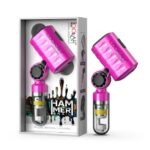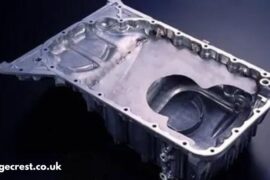Understanding your vehicle’s oil pan and maintaining it properly is crucial for the longevity and performance of your engine. The oil is a vital component in the engine system, playing a key role in lubrication. This guide will walk you through everything you need to know about oil pans, from their function to maintenance tips, and how to address common issues.
What is an Oil Pan?
The oil pan is a metal container located at the bottom of your vehicle’s engine. Its primary function is to store the engine oil, which lubricates the engine’s moving parts. It also helps in cooling the oil and trapping metal particles and other debris.
Functions of an Oil Pan
An oil, also known as the sump, is located at the bottom of the engine and serves several key functions. Primarily, it stores the engine oil, allowing it to be circulated throughout the engine for lubrication. Additionally, it provides a reservoir where the oil can settle and cool down before being pumped back into the engine.
Types of Oil Pans
- Stock Oil Pans: These are the standard oil that comes with most vehicles. They are designed to meet the needs of everyday driving.
- Performance Oil Pans: Used in high-performance and racing vehicles, these oil pans are designed to hold more oil and provide better cooling and lubrication.
- Dry Sump Oil Pans: Common in race cars, dry sump oil use an external reservoir to store oil, ensuring a consistent oil supply even under extreme conditions.
Components of an Oil Pan
Oil pans come in various materials, including aluminum, steel, and composite materials. Each type has its benefits and drawbacks. Inside the oil, you’ll find structural components like baffles, which help prevent oil sloshing around, and the oil pump pickup tube, which ensures that oil is consistently drawn into the engine.
Oil Pan Design
The design of an oil can vary based on the vehicle’s needs. Traditional designs are generally simple and effective, but high-performance vehicles may require specially designed pans to handle greater oil volumes and stresses. Custom designs are also available for enthusiasts looking to enhance their vehicle’s performance.
Common Issues with Oil Pans
Oil are not immune to problems. Leaks are one of the most common issues, often caused by damage or wear. Debris can also impact the oil, leading to dents or cracks. Corrosion can occur over time, especially in vehicles that are frequently exposed to harsh conditions.
Troubleshooting Common Oil Pan Issues
Identifying and addressing oil issues early can save you from more significant repairs down the road. If you notice oil spots where you park or hear unusual engine sounds, it’s essential to investigate promptly. A visual inspection can reveal cracks, dents, or corrosion that might indicate a problem. In some cases, a damaged oil might lead to oil starvation, which can cause severe engine damage. Regular maintenance, such as checking for leaks and ensuring proper oil levels, can help prevent these issues and keep your engine running smoothly.
Understanding Oil Material Choices
When it comes to oil pans, the material used can significantly affect performance and durability. Aluminum is a popular choice due to its lightweight and corrosion-resistant properties, making it ideal for high-performance vehicles. On the other hand, steel oil are known for their strength and cost-effectiveness, though they may be more prone to rust over time. Composite materials, such as reinforced plastics, offer a balance between weight and durability and can be a good choice for both every day and performance vehicles
Choosing Between OEM and Aftermarket Oil Pans
When it comes to replacing or upgrading your oil, you have the option of choosing between OEM (Original Equipment Manufacturer) and aftermarket parts. OEM oil are designed to match the specifications of your vehicle’s original parts, ensuring a perfect fit and compatibility. They’re generally reliable and come with a warranty. On the other hand, aftermarket oil offer a wider range of designs and materials, allowing for customization or performance enhancements. While aftermarket options might be more affordable or tailored to specific needs, it’s crucial to select high-quality brands to ensure they meet the necessary standards and provide reliable performance
Signs of Oil Problems
How do you know if your oil is having issues? Look for oil puddles under your vehicle, as this can indicate a leak. Unusual engine noises or a low oil pressure warning can also be signs that your oil is not functioning properly. Regular inspections of your oil are crucial. Make sure to check for leaks or any signs of damage. Keeping the oil clean and performing regular oil changes can also help extend its lifespan.
Replacing an Oil Pan
If you discover significant damage or persistent leaks, it might be time to replace your oil. The replacement process can be done as a DIY project if you’re handy with tools, but professional services are available for those who prefer to leave it to the experts. When selecting an oil, consider factors such as material, design, and compatibility with your vehicle. Brands like Moroso and Canton Racing offer high-quality options for various needs.
Oil and Engine Efficiency
The design of your oil can have a significant impact on engine efficiency. A well-designed oil ensures proper oil circulation and helps maintain optimal engine temperature, which can enhance overall engine performance and longevity. Upgrading your oil can bring several benefits, including improved oil flow and increased capacity. This is particularly useful for performance vehicles that require higher oil volumes to maintain engine health.
FAQs About oil pan
What is the main function of an oil pan?
The oil pan stores and helps circulate engine oil, providing lubrication and cooling for the engine.
How do I know if my oil pan needs to be replaced?
Look for signs like oil leaks, engine noise, or low oil pressure warnings.
Can I replace the oil pan myself?
Yes, if you have the right tools and skills, but professional help is available if needed.
What materials are oil pans made from?
Oil pans are typically made from aluminum, steel, or composite materials.
How does an upgraded oil pan benefit my engine?
An upgraded oil can improve oil flow, increase capacity, and enhance overall engine performance.
Conclusion
The oil pan may not be the most glamorous part of your engine, but it’s undoubtedly one of the most important. Understanding its functions, recognizing potential issues, and maintaining it properly can make a big difference in your vehicle’s performance. Whether you’re replacing a damaged oil or upgrading for better efficiency, keeping this component in good shape is essential for a smooth-running engine.











